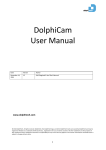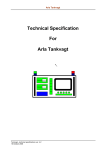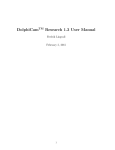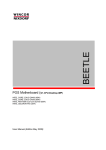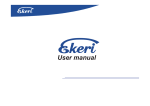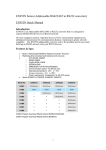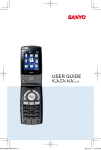Download DolphiCam User Manual 1.5
Transcript
DolphiCam User Manual Date Version Author July 28, 2015 1.5 Albert Payaro, Eskil Skoglund & Jan Olav Endrerud www.dolphitech.com © 2014 DolphiTech. All rights reserved. DolphiTech, the DolphiTech logo, and other DolphiTech marks are owned by DolphiTech and may be registered. Windows is a trademark of Microsoft Corp., registered in the U.S. and other countries. All other trademarks are the property of their respective owners. DolphiTech assumes no responsibility for any errors that may appear in this manual. Information contained herein is subject to change without notice. 1 2 Contents 1. Overview 1.1 General 1.2 Visualization 1.3 Materials 1.4 DolphiCam 1.4.1 DolphiCam Hardware Upgrade – Mark I versus Mark II 1.4.2 In the Box 1.4.3 Off/Mode Switch 1.4.4 Scan Button 1.4.5 Charging 1.4.6 Installing Software 1.4.7 Connecting and Starting the Camera 1.4.8 Low Battery 1.4.9 Sleep mode 1.5 Starting Application 1.6 Software Overview 1.6.1 Calibrating the Camera 1.6.2 Taking Images 1.7 C-Scan 1.8 A-Scan 1.9 B-Scans 1.9.1 Vertical B-Scan 1.9.2 Horizontal B-Scan 1.10 3D View 1.11 DolphiCam Settings & Functionality 1.11.1 Start Gate and End Gate 1.11.2 Amplitude Threshold 1.11.3 Color Focus 1.11.4 Measurement in C-Scan 1.11.5 Depth Measurement in B-Scan 1.11.6 Unit 1.11.7 Material depth 1.11.8 Number of Amplitude Gates 1.11.9 Number of ToF Gates 1.11.10 Material Sound of Speed 1.11.11 Transmitting Elements 1.11.12 Analog Gain 1.11.13 Number of Averages 1.11.14 Transmitting Pulse Shape 1.11.15 Time Corrected Gain 1.11.16 Editing Custom Gain Values 1.11.17 Time of flight Palette 1.11.18 Amplitude/B-Scan palette 1.11.19 Custom palettes 1.11.20 Amplitude Auto Color Focus 1.11.21 Stitching Overlap 1.11.22 C-Scan Capture Method 1.11.23 ToF Statistical Mode 1.11.24 Amp Running Average 1.11.25 Drilled Hole Inspection 1.11.26 Drilled Hole Measurement Tool 1.11.27 A-Scan Envelope 1.11.28 Save 1.11.29 Load 3 5 5 5 7 7 7 7 8 8 8 9 9 10 10 11 11 11 13 13 15 15 15 16 16 17 17 18 20 21 22 22 22 23 24 24 24 25 26 26 27 28 29 29 29 30 30 30 31 31 32 32 33 34 34 1.11.30 Reset 1.11.31 Close 1.12 Manual Stitching 1.13 Menu Items 1.14 Controlling DolphiCam Settings 2. Technical Specifications 3. Troubleshooting 4. Installing Software 5. Handling, Safety & Support 5.1 Cleaning the DolphiCam 5.2 Important safety information 5.3 DolphiCam Support 5.4 Disposal and recycling information 6. License terms 34 34 35 39 39 39 40 41 43 43 43 43 44 44 4 1. Overview 1.1 General DolphiCam is an advanced ultrasound camera designed for test and inspection of CFRP (Carbon fiber reinforced plastic) to detect material flaws and defects. The DolphiCam connects to a standard Windows PC or Windows tablet (not included), making it easy to view and interpret results. There are two main versions of DolphiCam: - DolphiCam CF08 (can inspect CFRP up to ~8mm thickness) - DolphiCam CF16 (can inspect CFRP up to ~16mm thickness) The CF08 has higher frame rate and typically better resolution in the range 1-8mm thickness (CF16 has a thicker dry coupling which leads to wider spread of the ultrasound from each transducer element). The camera has a transducer with 124 x 124 (15376) elements over the 31x31 mm transducer (16 elements/mm2), capable of detecting very small defects. The transducer pad is silicone-based, enabling dry coupling on smooth and painted surfaces. Water or contact gel can be used to improve coupling on rougher surfaces. 1.2 Visualization DolphiCam supports the following visualization images: · A-Scan · B-Scans o B-Scan Horizontal o B-Scan Vertical · C-Scans o Amplitude (Amp) o Time-Of-Flight (ToF) · Stitched C-Scans (Amplitude or Time-Of-Flight) · 3D View The DolphiCam Graphical User Interface can be displayed in two different modes: · PC Mode (Menus are found on the top left of the application) · Tablet Mode (Menus are located on the right of the application and are “touch-friendly”) 5 PC mode: Tablet mode: For each Mode, 4 Views are available: · All: Displays A-, B-, C-Scan (Amp and ToF) at the same time. · Classic: Displays. A-, B- and C-Scan (Amp or ToF) · 1 x C-Scan: Presents A and C-Scan (Amp or ToF) · 2 x C-Scan: Presents A and C-Scan (Amp and ToF) 6 1.3 Materials The DolphiCam is designed for the following materials: Material type CFRP (Carbon fiber reinforced plastic) Min. approximate thickness ~ 1 mm Max. approximate thickness ~ 8 mm (CF08) ~16 mm (CF16) NOTE: Depending on the exact material variant, material additives, surface treatment and surface structure, exact minimum and maximum thicknesses may vary. 1.4 DolphiCam 1.4.1 DolphiCam Hardware Upgrade – Mark I versus Mark II As of June 2015 DolpiTech offers and hardware upgrade Mark II. For Mark II hardware, the receiver electronics has been modified to improve the signal-to-noise ratio by ~12dB. The Mark I and Mark II are still compatible but will have a slightly different gain and TCG performance. For compatibility details, view application notes on http://www.dolphitech.com/support/. (“Application Note 07 - Gain Compatibility Mark I & Mark II”) “Mark I” DolphiCam: - Hardware version 4, 5, 6, 7 (CF08) & hardware version 10, 11 (CF16) “Mark II” DolphiCam: - Hardware version 8 (CF08) & hardware version 12 (CF16) 1.4.2 In the Box The DolphiCam comes in a protective case. Contents: · DolphiCam with a protective cap · USB stick with DolphiCam software · Plexiglas “flower” for demonstration purposes · Charger (EUR, UK or US standards) · Spare protective cap 7 1.4.3 Off/Mode Switch Turn the camera ON/OFF, and switch between different camera modes. Position Off 1 2 3 Calibrate Description The Camera is turned OFF The Camera is ON Reserved, currently the same as Mode 1 Reserved, currently the same as Mode 1 Camera in Calibration Mode 1.4.4 Scan Button Start / end scanning. The Scan Button must be clicked (press-and-release) to start scanning video images. The Scan Button must be clicked again to freeze the images (stop scanning). The Scan LED is placed in the camera top, oriented towards the operator, just below and to the right of the Scan Button. Scanning images To start scanning To view a live image stream from the camera To end scanning and freeze current image Action Click Scan Button Leave the scan button Indication Scan LED switches from red to green light Scan LED is green Click Scan Button again Scan LED switches from green to red light Make sure that you do not unintentionally leave the camera in scanning mode, as this will drain the battery. 1.4.5 Charging The DolphiCam is delivered with some power in its internal battery. The camera should be fully charged with the supplied charger before first use. Charge DolphiCam with the included USB cable or power adapter. Using damaged cables or chargers, or charging when moisture is present, can cause electric shock. Power adapters may become warm during normal use, and prolonged contact may cause injury. Always allow adequate ventilation around power adapters when using them. If the camera is left scanning or just on (position 1, 2, 3, Calibrate), when not in use, the battery will drain and might become completely discharged. If battery is completely discharged, you must charge while DolphiCam is “OFF” for at least 30 minutes before continue use. It is not recommended to operate DolphiCam (scanning) when battery is completely discharged, as this will strain the charger more than maximum charge current (2A). Although the charger has protective circuits, the charger may become very warm. As with any equipment containing high-energy Li-Ion batteries, it is not recommended to leave the equipment unattended when it is charging. Charging the DolphiCam to full capacity will take up to 5 hours using the charger. The charging LED is RED when the camera is charging. The charging LED is GREEN when the camera is fully charged. 8 NOTE: The DolphiCam charges whenever the camera is connected to an USB port. NOTE: Make sure the camera is turned OFF using Off/Mode Switch before charging. 1.4.6 Installing Software See Installing Software (chapter 4). 1.4.7 Connecting and Starting the Camera When the software installer has finished, connect the camera to the PC by inserting the USB plug. NOTE: The USB connector should only be connected to protected Class III circuits. Turn the camera ON by setting the Off/Mode Switch to “1”. It is optional to turn the camera ON before it is connected. If the camera is turned OFF when it is connected, the application waits until a camera is detected. Waiting for camera to be plugged in (USB) and turned on: 9 DolphiCam is detected and Software is ready: 1.4.8 Low Battery Low battery is indicated in the software by a blinking battery symbol in top left corner. 1.4.9 Sleep mode To save battery for unnecessary draining, the camera has enabled sleep mode by default. If leaving DolphiCam scanning unintentionally for 15 minutes, a warning message will occur, and the camera will stop scanning and go into standby/sleep mode in 60 seconds. Sleep mode can be disabled/enabled from the Tools menu: 10 1.5 Starting Application Start the DolphiCam software by clicking on the icon on your desktop. Alternatively, start DolphiCam with the name of a DolphiCam configuration file as a parameter: Example: C:\Program Files (x86)\DolphiTech\DolphiCam\DolphiCam.exe <mysettings>.dolphicam You can also double click on the configuration file to start DolphiCam software. 1.6 Software Overview Main window: 1.6.1 Calibrating the Camera Before use, the camera must be calibrated. This will ensure that the ultrasound system is adjusted to the small variances in the transducer as an effect of microscopic deformations, temperature variations and other factors. Calibration is performed towards air. 11 The Calibration Wizard starts the first time the camera is connected to the PC: · · · · · · Make sure transducer surface is clean Point the camera towards air and turn Mode Switch to “Calibrate”. Click the Scan Button to start scanning (not necessary for first calibration) The calibration sequence will take a few seconds. Turn Mode Switch back to “1” when the calibration is finished. Click the Scan Button again to stop scanning. The camera can be re-calibrated at any time, and all pulses are calibrated. The calibration is not affected by camera settings. 12 1.6.2 Taking Images Click the Scan Button to start scanning video. Click the Scan Button again to freeze image (stop scanning). When scanning towards air, the result will look something like this: 1.7 C-Scan The C-Scan represents the material as seen from the transducer directly into the material. Two C-Scan modes are available; Amplitude and Time-of-Flight. DolphiCam scans in both Amplitude and Time-of-Flight modes and data is recorded independent of which scan mode the application is in. The user can at any time switch between the two image modes by pressing Amplitude or Time-of-Flight buttons in the application. In some of the views, the C-Scan Amplitude and Time-Of-Flight are both available. 13 Amplitude The color in amplitude C-Scan image shows the intensity of the maximum value of your reflected pulse within your gate. Time-of-Flight (TOF) The color in TOF C-Scan shows the depth of the reflected pulse within your gate. Notice the blue back wall and the different colors of the defect. Stitch mode DolphiCam supports a powerful manual stitch mode, making it easy to create multi-tile images covering a large area. See chapter 1.12 for stitching. 14 1.8 A-Scan The A-Scan is presented in the bottom, left part of the application. The A-Scan displays a signal processed time series of the ultrasound reflection from the material at the intersection between the C-Scan crosshairs, over the depth of the material. 1.9 B-Scans The B-Scan represents a cross-section through the material. There are two B-Scans; a vertical B-Scan and a horizontal B-Scan. The B-Scans are taken at the position of the white lines in the C-Scan image. To reposition the B-Scans, click inside the C-Scan to move the white cross-hair to a different position. The cross-hair will reposition itself at the time of the next picture frame. 1.9.1 Vertical B-Scan The vertical B-Scan is positioned to the left of the C-Scan, and above the A-Scan. The vertical B-Scan displays a vertical cross-section at the position of the vertical line in the C-Scan image. Notice the relationship to the color in C-Scan TOF image and the depth of the reflections/defects in your B-Scan. The start- and end gates can be set by clicking near the gates in the vertical B-Scan, or by modifying the gate values above (gating is described more in detail in chapter 1.11.1). 15 1.9.2 Horizontal B-Scan The horizontal B-Scan is positioned to the right of the A-Scan, and below the C-Scan. The horizontal B-Scan displays a horizontal cross-section at the position of the horizontal line in the C-Scan image. 1.10 3D View Data from the Time-of-Flight scan is used to give a 3D representation of the material and any defects. 3D image is available in view:All and otherwise enabled by pushing 3D button in the other views. The image can be zoomed, panned or rotated using the mouse or screen touch. Screen control: Mouse wheel Scroll in or out Hold left mouse button Pan Hold right mouse button Rotate Cube in lower, right corner; U, D View from upside or bottom Cube in lower, right corner; F, B View from front or back Cube in lower, right corner; L, R View from left or right 16 1.11 DolphiCam Settings & Functionality 1.11.1 Start Gate and End Gate Setting your gate enables you to study a specific depth of your material. The start and end gate can be set between -0.38 mm and 8.8 mm (CF08) or 18.38mm (CF16). The gates can be set in different ways: · Entering a specific depth in the Start Gate and End Gate fields respectively, or · Adjusting the gates using the + (plus) and – (minus) buttons on each side of the Gate Value field, or · Click the mouse in the vertical B-Scan to get your desired gate. If the cursor is closest to the Start Gate line, the Start Gate value will be adjusted. If the cursor is closest to the End Gate line, the End Gate value will be adjusted. NOTE: · · · · The gate values will take effect in your next image. Amplitude image and Time-of-Flight image have separate Start Gate and End Gate settings. With the “2 x C-Scan” view, the start and end gates are adjusted in the A-Scan With “All” View, the user can switch between the Amp and ToF Start and End Gate by clicking on the buttons at the left of the Vertical B-Scan (see image below). 17 1.11.1.1 Multiple Gates Both C-Scan ToF and C-Scan amplitude has up to 3 separate gates, enabling you to inspect several different sections of your material and ignore other sections. Each gate has their own amplitude threshold (view chapter 1.11.2). In the C-Scan only views (1 x C-scan, 2 x C-Scan), the gating is available in the A-Scan in bottom of GUI as shown below. In this view the control buttons and numbers are not available. 1.11.2 Amplitude Threshold The blue horizontal line in the A-Scan sets the amplitude threshold (0-100%). All signal amplitudes below the threshold will be ignored: 18 Amplitude threshold for 3 gates: For C-Scan Amplitude and B-Scan images: · All signal amplitudes below the lowest amplitude threshold will be interpreted as the same value as the threshold value. For C-Scan TOF and 3D image: · All signal amplitudes below the lowest amplitude threshold will be ignored and given the color grey. 19 1.11.3 Color Focus By default, the DolphiCam will spread colors in the palette evenly over 0-100% in Amplitude Images and over the complete depth in TOF image. By using the Color Focus Slide Bar to the right of the C-Scan, it is possible to focus the colors in a smaller part of the color scale. The color focus is possible for both amplitude images (%) and Time of Flight images (depth – mm/inches/mils). There is a top slider and bottom slider to control the color focus. You can also move the selected color focus by click-and-hold in between the top and bottom slider and drag your color focus area up and down. Time-of-Flight Color Focus In Time-of-Flight image, all colors above the top slider will be given the color of the top slider, and all values below the bottom slider will be given the value of the bottom slider. Amplitude Color Focus In all amplitude images (C-Scan and B-Scan), all colors above the top slider will be given the color of the top slider, and all values below the bottom slider will be given the value of the bottom slider. 20 1.11.4 Measurement in C-Scan Measuring can be done when measuring line button is activated. You can measure by left-clicking drag-and-hold*. *You can add up to 10 measure lines. 21 1.11.5 Depth Measurement in B-Scan If measure control is enabled ( ) you can measure by left-clicking drag-and-hold in any of the B-scans, you can measure the depth and the size of the defect. This is useful for measuring the size of material defects. You can add up to 10 measure lines in each of the B-Scans. 1.11.6 Unit Sets the units for the system. Setting Unit Input Select from dropdown list: · Millimeters (mm) - default · Inches (in) · Mils (1/1000 inches) 1.11.7 Material depth Limits the material thickness to be examined. Sets the depth scales for A-Scan and B-Scan. Also, this affects the color distribution in C-Scan TOF. It is recommended to set the Material Depth to just include your back wall echo, as this takes advantage of all the colors in your palette. 22 Setting Material depth CF08 Input Use slider; select an approximate material thickness in the range: · 1.1 – 8.8 mm, or · 0.044 – 0.317 inches, or · 44 – 317 mils Material depth CF16 Use slider; select an approximate material thickness in the range: · 1.1 – 18.4 mm, or · 0.044 – 0.723 inches, or · 44-723 mils 1.11.8 Number of Amplitude Gates C-Scan Amplitude can have 1, 2, or 3 gates to inspect one or several sections of your material. Setting Number of Amplitude Gates Input Select from dropdown list: · 1 · 2 · 3 To control each gate, simply click closest to the start or end gate you want to control to activate this gate. You can also select the gate by writing or scrolling in the small gate-index window between the Start Gate box and End Gate box. 23 1.11.9 Number of ToF Gates C-Scan Time-Of-Flight can have 1, 2, or 3 gates to inspect one or several sections of your material. Setting Number of ToF Gates Input Select from dropdown list: · 1 · 2 · 3 To control each gate, simply click closest to the start or end gate you want to control to activate this gate. You can also select the gate by writing or scrolling in the small gate-index window between the Start Gate box and End Gate box. 1.11.10 Material Sound of Speed Sound of speed in m/s or ft/s for the material. Setting Material sound of speed Input Set value: · Enter numeric value (default=3000 m/s) for the material to be examined 1.11.11 Transmitting Elements The transmitting energy can be adjusted using different number of transmitting elements (1-8). Transmitting a higher number of elements gives higher energy and focus at higher depths. Transmitting fewer elements gives less energy but might give higher resolution for very thin composite materials. Note that the transmitting elements are aligned next to each other along an array in the vertical direction. 24 The default number of transmitting elements is 4 for CF08 and 8 for CF16. Setting Transmitting elements Input Select from dropdown list: · 1 · 2 · 3 · 4 – default (for CF08) · 5 · 6 · 7 · 8 – default (for CF16) 1.11.12 Analog Gain Easy analog gain control to raise/lower the gain in receiver electronics. When TCG (time corrected gain), is enabled, the analog gain control will raise/lower the complete TCG profile. Setting Analog Gain Input Control with +/- buttons: · Range 1.3 dB to 50,8 dB (MarkI) Range 24,9dB to 74,5dB (MarkII) (Default: Different default gain adapted for each transmitting pulse shape) When mixing gain settings between MarkI & MarkII hardware, the gain will “snap” into the closes possible gain. (Ref: Application Notes on http://www.dolphitech.com/support/ . (“Application Note 07 - Gain Compatibility Mark I & Mark II”) 25 1.11.13 Number of Averages Noise reduction strategy. You can choose how many averages the system runs on each transducer element. A lower number of averages gives you slightly poorer Signal-to-Nose ratio, but a higher frame rate. Setting Number of averages Input Select from dropdown list: · · · · 1 (gives higher frame rate) 2 - Default: Noise reduction based on 2 ultrasound samples. The noise reduction is good, but the frame rate is higher; ~4 images per second for CF08, ~2 images per second for CF16 4: Noise reduction based on 4 ultrasound samples. This noise reduction is higher, at the cost of a lower frame rate; ~2 images per second for CF08, and ~1 image per second for CF16 8 (gives higher SNR) 1.11.14 Transmitting Pulse Shape DolphiCam has 8 different user selectable transmitting pulse shapes for CF08 and 4 different pulses for CF16. Each pulse shape has an adapted digital filter. The combination of the nature of the pulse shape and the adapted digital filtering makes each pulse special in the sense of different parameters, such as Signal-toNoise ratio, pulse length, etc. Each of the different pulse shapes has different qualities that makes them suitable for different material, material thickness, size of defect, etc. Setting Transmitting Pulse Shape CF08 Input Select from dropdown list: · 1 - default · 2 · 3 · 4 · 5 · 6 · 7 · 8 Transmitting Pulse Shape CF16 Select from dropdown list: · 1 - default · 2 · 3 · 4 26 1.11.15 Time Corrected Gain Gain adjustment (analog) as a function of time/depth. With time corrected gain, it is possible to adjust the amplification (or dampening) of signals at a specific depth. The system has 5 different preset ramp-ups and can also be set custom. Setting Time Corrected Gain (Mark I) Input Select from dropdown list: · Off – default · 0.46 dB/µs (Preset 1) · 0.69 dB/µs (Preset 2) · 1.38 dB/µs (Preset 3) · 2.76 dB/µs (Preset 4) · 4.13 dB/µs (Preset 5) · Custom (edit settings) Time Corrected Gain (Mark II) Select from dropdown list: · Off – default · 0.46 dB/µs (Preset 1) · 0.50 dB/µs · 0.69 dB/µs (Preset 2) · 1.00 dB/µs · 1.38 dB/µs (Preset 3) · 1.50 dB/µs · 2.00 dB/µs · 2.50 dB/µs · 2.76 dB/µs (Preset 4) · 3.00 dB/µs · 3.50 dB/µs · 4.00 dB/µs · 4.13 dB/µs (Preset 5) · Custom (edit settings) Except for Custom Preset, the Time Corrected Gain can only be viewed, not edited. Note the maximum gain for DolphiCam: - Mark I hardware has maximum gain is 50,8 dB (hardware version 4, 5, 6, 7, 10, 11) - Mark II hardware has maximum gain is 74,5dB (hardware version 8 & 12) When using TCG curves, the user must observe and be aware if gain reaches maximum allowable gain! (Ref: Application Notes on http://www.dolphitech.com/support/. (“Application Note 06 – Maximum gain for MarkI Hardware”) When mixing TCG settings between MarkI & MarkII hardware, the gain will “snap” into the closes possible TCG curve. (Ref: Application Notes on http://www.dolphitech.com/support/. (“Application Note 07 - Gain Compatibility Mark I & Mark II”) 27 1.11.16 Editing Custom Gain Values Open Time Corrected Gain Settings by selecting “Custom” from the drop-down menu and click the “Edit” button. (Click Edit). Adjust the gain at a specific depth by clicking and dragging its handle (blue button) vertically. The values along the top horizontal bar shows the analog gain [dB] set at the respective time in your A-scan. The TCG time interval is 0,9375µs between each gain setting. There is a maximum limit of ~10 dB step between two points (0,9375 µs) to ensure stability in the electronics. Detailed Custom TCG: There is also a detailed TCG option that can be enabled by checking the “Detailed” box. You then get twice as many TCG points 0,46875 µs apart. The maximum limit of ~10 dB per step is then valid between two detailed points (0,46875 µs). 28 1.11.17 Time of flight Palette User selectable color palette for TOF images. Setting Time of flight Palette Input Select from dropdown list a color palette. Default is JetColorPalette 1.11.18 Amplitude/B-Scan palette User selectable color palette for Amplitude and B-Scan images. Setting Amplitude/B-Scan palette Input Select from dropdown list a color palette. Default is JetColorPalette 1.11.19 Custom palettes By clicking the “Manage” button, the user can add their own Custom Color Palette File. The color palette file format must be a *.txt file and should have 256 rows of decimal RGB values (Red Green Blue values). Examples of a color palette can be found at http://www.dolphitech.com/support/. Your added color palette will occur in the drop down menu of “Time of Flight Palette” and “Amplitude / B-Scan Palette” with the same name as your filename. An example of the beginning and end of a color palette file is shown below. 29 Color palette file example: 255 255 255 254 254 254 253 253 253 252 252 252 … … … 4 4 4 3 3 3 2 2 2 1 1 1 0 0 0 1.11.20 Amplitude Auto Color Focus Automatically calculate and apply the complete color spectrum in the image. If this option is selected, user selected color focus is not possible – and the color focus selector is removed from the edge of the C-Scan. Setting Amplitude auto color focus Input Select from dropdown list: · On · Off – default 1.11.21 Stitching Overlap DolphiCam has a manual stitching functionality described in chapter 1.12. The overlap between the stitched images can be controlled by the Stitching Overlap slider. The number in parenthesis shows the distance from center-to-center between each C-Scan frame. This number can help you set a grid for your material for inspection. 1.11.22 C-Scan Capture Method The C-Scan images (Amplitude & Time-Of-Flight) are based on the amplitude and time of the maximum amplitude of reflected pulse within your set gate. The user can control if the system should capture the maximum absolute value, maximum positive value, or maximum negative value. Setting Capture Method Input Select from dropdown list: · Max Absolute · Max Positive · Max Negative 30 1.11.23 ToF Statistical Mode ToF Statistical Mode is an algorithm that will smoothens your streaming ToF C-Scan image and makes it less sensitive for movement of the camera and will give you better results and stability where your reflected pulse is close to the noise floor or you have a complex combination of reflections (f.ex. for drilled hole inspection). This works especially well when enabling drilled hole inspection (region of interest which gives a much higher frame rate). Default setting: 1 images (no effect) So this is how it works: The user can control how many samples included in the ToF statistical mode algorithm. For each transducer element, the algorithm will select the ToF value that occurs the most within the number of samples set. If set to 1 sample, the algorithm only uses the most recent image, which is the same as if the algorithm is not enabled. Below is shown an explanation of one transducer element where algorithm is set to use 10 samples. As you can see, the value 303 is what occurs the most. The color in your ToF C-Scan image for that transducer element will then only represent the value 303 and will completely ignore the other values. 1.11.24 Amp Running Average The Amp Running Average is a common image processing algorithm and will also smoothen your streaming amplitude C-Scan image by using information from previous images. It creates a “delay” in your amplitude C-Scan. Default setting: 1 Alpha (no effect) The algorithm is controlled by the unit Alpha. Alpha is the “forgetful factor” which regulates the update speed of the image - how fast the accumulator “forgets” about earlier images. If alpha is set to 1.00, it 31 means that the algorithm forgets all previous images and only uses the most recent image, which is the same as if the algorithm was not enabled. 1.11.25 Drilled Hole Inspection Drilled hole inspection enables you to inspect drilled holes robust, fast and effectively. What it does is to only use a selected region of interest in the middle of the transducer. It only runs through ~3300 transducer elements instead of all 15376 elements (view figure below for explanatory figure). This gives you a faster frame rate which gives the user fast feedback and enables him/her to find the correct area of inspection and adapted pressure to camera on the hole. The fast frame rate is very beneficial when using the image algorithms, ToF Statistical Mode and Amp Running Average. Another benefit with the reduced region of interest, is that it is even easier to obtain coupling over the complete are of interest. To activate the drilled hole inspection: - PC mode: <Tools><Drilled Hole Inspection> - Tablet mode: 1.11.26 Drilled Hole Measurement Tool When enabling the drilled hole inspection, the drilled hole measurement tool is available. To enable to the measurement tool, open the settings window and push the <Drilled Hole Measurement> button. Once enabled, you will get the measurement circles and lines overlaying your C-Scan images, and a control and result GUI will pop up as shown below. 32 There is an inner circle and outer circle. The inner circle is used as a reference of your actual hole. The outer circle is to set your maximum allowable defect zone, or to actually measure the size of your defect. The circles can be controlled either by click-and-drag inside the C-Scan or by pushing the +/- control buttons in the measurement control interface. The aligning of the circles can be moved around in the C-Scan either my click-and-drag inside the inner circle or the help circle on bottom right corner. Lastly, you can set the angle that embraces the defect. This is also controlled either by click-and-drag the lines inside the circles, or by using the control interface. Once you have aligned your circles and set the correct size/angle on your circles and lines, you can read out the size parameters. Radial Damage size: - Distance between the inner and outer circle. Circumferential arc - Length of arc between the two lines on outer circle Circumferential angle: - Angle between the two lines. The user can also change the color of the measurement circles and lines using the color scheme. 1.11.27 A-Scan Envelope The user can select whether he wants the A-Scan to be displayed with or without the envelope function respectively (see images below). When disabling A-Scan envelope, notice that the pulse then is centered around the middle of the A-Scan view and the scales is changed with reference 0 % in the middle of the view. The amplitude threshold line is then always referenced at 0% (bottom of A-scan view when envelope is enabled and middle of the A-Scan view when envelope is disabled). 33 1.11.28 Save The current settings are stored to the DolphiCam Profiles folder with a .DolphiCam file extension. See Controlling DolphiCam Settings (chapter 1.14) for more information. Setting Save settings… Input The current settings are stored to the DolphiCam Profiles folder with a .DolphiCam file extension. 1.11.29 Load Load settings from the DolphiCam Profiles folder with a .DolphiCam file extension. Setting Load settings… Input Load settings from the DolphiCam Profiles folder with a .DolphiCam file extension. 1.11.30 Reset Resets all settings to default values. 1.11.31 Close Close the DolphiCam settings window (in PC Mode). Tablet Mode only allows to show/hide the Camera settings by clicking of the arrow button: 34 1.12 Manual Stitching Manual stitching is a powerful and effective way to create larger images made of multiple C-Scans. To start manual stitching: · PC Mode: go to <Tools><Manual Stitching>. To leave stitching mode and go back to main window go to <Tools><Exit Stitching>. · Tablet Mode: Click on the following button: One way of using stitching mode, is to simply start taking your first image and click one of the arrows around your C-scan to continue stitching in the direction you choose. Each tile in the stitch is as big as the transducer front (31x31mm). The tiles overlap by 6mm (default), which means that the tiles (center-tocenter) are 25mm (~1 inch) apart. The stitching overlap can be adjusted in settings. The camera should be oriented in the same angle for each image taken (this is relatively easy). If your C-scan images are not perfectly aligned, simply move them around with your mouse or arrows on your keyboard (view top image below). You can also control the overlap on images by right-clicking and selecting “Bring to front”, or “Send to back” (view bottom image below). 35 36 When inspecting a larger predefined area, the easiest way to stich is to use the sequence mode. First you click the arrows on your stitching image until you have covered the desired area. Then simply click on the sequence button , and your sequence will displayed for you. Whenever you click to freeze your C-scan image, the image moves to the next tile in your stitch. To view your complete scan, increase the number of tiles in your view by clicking on the +/- button or enter the number of tiles desired. Click on the measure line button to enable measure lines. Right click on your mouse and drag to add your measure lines (while measure lines are enabled, the “Bring to Front/Send to back” function is disabled). To reset your stitching procedure, click the reset button your view, measure lines, and sequence. 37 . All your images will then be deleted, as well as Stitching tip: If you set your stich overlap to 25mm (~1 inch) apart, you can prepare your measurement by marking your material for inspection with dots 25mm (~1 inch) apart in all directions, either by using a ruler or f.ex. a silicon sheet with pre-cut holes in it. Using these predefined marks, you can easily aim at them using one of the lines in DolphiCam housing. Doing this really simplifies and speed up your inspection. 38 1.13 Menu Items Menu File menu Item Save Images Description Creates a ZIP file containing: · TimeOfFlight.[png|tif|bmp|jpg] · AScan.[png|tif|bmp|jpg] · BScanVertical.[png|tif|bmp|jpg] · BScanHorizontal.[png|tif|bmp|jpg] · CameraSettings.txt Tools menu Take Screenshot Copy to Clipboard Export C-scan to NDT-kit DolphiCam settings… Manual Stitching… User Guide (PDF) About DolphiCam… Creates a [png|tif|bmp|jpg] image of main window. Copies screenshot to clipboard (Ctrl-C also works) Export C-scan to NDT-kit file format Open DolphiCam settings (page 17) Enters manual stitching mode (page 35) Opens the User Guide (PDF format). Display serial number, camera description, software version, firmware version, hardware version, and camera type. Opens the link to DolphiTech support page. Help menu Support… 1.14 Controlling DolphiCam Settings DolphiCam settings are configured using Tools > DolphiCam Settings. Settings are stored in separate setting files. This makes it easy to handle different settings for different NDT scenarios. Some settings are controlled in the main window; amplitude threshold, gate-values, color focus, C-Scan image selection. · · Save settings… o Save settings to a settings file Load settings… o Load settings from a settings file Setting files are stored in the Profiles folder, located in C:\Users\Public\Documents\DolphiCam\Profiles folder (Windows 7), and have a .DolphiCam extension. DolphiCam can be started with a setting file as a startup parameter: <path to dolphicam.exe>\dolphicam.exe <.DolphiCam file> Example: Start DolphiCam with the settings file impact01.DolphiCam located in the default setting folder: C:\Users\Public\Documents\DolphiCam\Profiles\DolphiCam.exe impact01.DolphiCam 2. Technical Specifications Dimensions 115 x 170 x 68 mm / 4.5” x 6.7” x 2.7” Weight 0.470 kg / 1.04 lbs. Detection and inspection Transducer CFRP composite materials < 8 mm thickness for CF08 and < 16mm for CF16 31 mm x 31 mm capture size 124x124 elements, 16 elements/mm2 over 31 x 31 mm Power Re-chargeable Li-ion battery Charging Charger or USB. Nominal charge 1.1 A Battery charger Artesyn DA 12-050MP-M (included) 39 Battery rating Li Ion 3.6V 6200 mAh (internal battery) Battery life ≈ 5 hours of continuous scanning Communication USB 1.1 / 2.0 Operating temperature 0˚ to 40˚ C / 32˚ to 104˚ F Storage temperature -20˚ to 65˚ C / -4˚ to 149˚ F Max altitude < 18.000 m (maximum operating altitude) Pollution degree Pollution degree 2 Ingress Protection IP54 (Protection for dust and splashing water from all sides) EMC EN 61326:1997+A1:1998+A2:2000+A3:2003 / FCC Subpart 15 Electrical safety EN/IEC 61010-1:2001 Software and Display PC and Tablet devices running Windows XP SP3 and later or Windows 8. PC/tablet is not included. Automatic firmware and software updates. 3. Troubleshooting Problem Camera will not work The camera gets warm Resolution · Make sure the camera is connected to the USB port. · Try to restart the DolphiCam software. · Try to connect/reconnect the camera to the PC. · Charge the camera using the DolphiCam charger. · · · Low battery life · · The camera will get warm during normal operation. Make sure that the camera isn’t scanning images when you don’t intend to. Visually check that the Scan LED is out or red before you put the camera away. Always turn the camera OFF when you don’t use it, or it is stored in the case. Make sure that the camera isn’t scanning images when you don’t intend to. Visually check that the Scan LED is out or red before you put the camera away. Always turn the camera OFF when you don’t use it, or it is stored in the case. DolphiCam will not work on the Windows emulator on Mac, Linux or similar · DolphiCam is only supported on native MS Windows systems. DolphiTech gives no guarantees, or give any support on MS Windows emulating software. Camera housing or cables are damaged · · Do not use the camera. Send it back to the supplier for repair Noisy or unclear images · · · Make sure the object is clean. Clean the transducer pad. Try using contact gel or water to improve coupling. Noise in the picture · · · · Tune the scanning and/or camera setting. Use coupling water or gel. Clean the Transducer Pad Check Transducer Pad for damages. A camera with a damaged Transducer Pad must be repaired. 40 4. Installing Software Insert the USB stick in your computer. Navigate to the USB disk in Windows Explorer, and start the setup application. Follow the instructions. Read, and agree to the license terms. Click Install. Installation will start. Setup will determine if an updated version of .NET needs to be installed. Microsoft .NET will be updated, in the background if necessary. DolphiCam USB drivers will also be installed in the background. Close DolphiCam setup. Restart the computer if asked to do so. 41 Setup is complete! 42 5. Handling, Safety & Support 5.1 Cleaning the DolphiCam Cleaning the DolphiCam housing Clean DolphiCam immediately if it comes in contact with anything that may cause stains—such as dirt, ink, paint or oil. Turn Off the DolphiCam and disconnect it from the PC. Wipe it off/clean it with a soft, lint-free cloth moistened with mild soap water. Remove the protective cap, and carefully clean around the Transducer Pad. Do not clean the silicone directly, as it will be cleaned separately. Do not use solvents of any kind. Avoid getting dirt into openings. Don’t use aggressive cleaning products or compressed air. Put the protective cap back on. Cleaning the Transducer Turn the DolphiCam Off, and disconnect it from the PC. Remove the protective cap. Clean the DolphiCam housing first, see above. Put a drop of mild dishwasher soap on the transducer pad and rub it gently with the tip of your finger. Dip your finger in water and rub on pad until soap is gone. Make sure the Transducer Pad isn’t scratched or damaged. Moist a soft, lint-free cloth with water and wipe off excessive water carefully. Put the protective cap back on. 5.2 Important safety information Charger Only use a charger specifically designed for your DolphiCam. Repairing Don’t open DolphiCam and don’t attempt to repair DolphiCam by yourself. Disassembling DolphiCam may cause injury to you or damage to DolphiCam, and will void all guarantee. If DolphiCam is damaged or malfunctions, contact DolphiTech or a DolphiTech Authorized Service Provider. You can find more information about getting service at www.dolphitech.com. Explosive atmospheres Do not charge or use DolphiCam in any area with a potentially explosive atmosphere, such as at a fueling area, or in areas where the air contains chemicals or particles (such as grain, dust, or metal powders). Obey all signs and instructions. Battery Don’t attempt to replace the DolphiCam battery yourself—you may damage the battery, which could cause overheating and injury. The lithium-ion battery in DolphiCam should be replaced only by DolphiTech or a DolphiTech Authorized Service Provider, and must be recycled or disposed of separately from household waste. Don’t incinerate the battery. For information about battery recycling and replacement, go to www.dolphitech.com. Handling Handle DolphiCam with care. It is made of metal and plastic and has sensitive electronic components inside. DolphiCam can be damaged if dropped, burned, punctured, or crushed or if it comes in contact with excessive amounts of liquid. Don’t use a damaged DolphiCam, such as one with a cracked housing, as it may cause injury. Keep the protective cap in place whenever the camera is not taking pictures. Store and transport the camera in the flight case. Using connectors, ports, and buttons The USB connector should only be connected to protected Class III circuits. Never force a connector into a port or apply excessive pressure to a button, because this may cause damage that is not covered under the warranty. If the connector and port don’t join with reasonable ease, they probably don’t match. Check for obstructions and make sure that the connector matches the port and that you have positioned the connector correctly in relation to the port. Operating temperature DolphiCam is designed to work in ambient temperatures between 32° and 104° F (0° and 40° C) and stored in temperatures between -4° and 149° F (-20° and 65° C). DolphiCam can be damaged and battery life shortened if stored or operated outside of these temperature ranges. Avoid exposing DolphiCam to dramatic changes in temperature or humidity. When you’re using DolphiCam or charging the battery, it is normal for DolphiCam to get warm. Choking hazard Some DolphiCam accessories may present a choking hazard to small children. Keep these accessories away from small children. 5.3 DolphiCam Support Comprehensive support information is available online at www.dolphitech.com. 43 5.4 Disposal and recycling information Your DolphiCam must be disposed of properly according to local laws and regulations. Because it contains a battery, DolphiCam must be disposed of separately from household waste. When your DolphiCam reaches its end of life, contact DolphiTech or your local authorities to learn about recycling options. Battery replacement: The lithium-ion battery in DolphiCam should be replaced only by DolphiTech or a DolphiTech Authorized Service Provider, and must be recycled or disposed of separately from household waste. For information about battery recycling and replacement, go to www.dolphitech.com/support. European Union—Disposal Information The symbol above means that according to local laws and regulations your product and/or its battery shall be disposed of separately from household waste. When this product reaches its end of life, take it to a collection point designated by local authorities. The separate collection and recycling of your product and/or its battery at the time of disposal will help conserve natural resources and ensure that it is recycled in a manner that protects human health and the environment. 6. License terms View License terms in “License Information” link in “About DolphiCam” window. DolphiTech AS Building 1, Raufoss Industrial Park N-2830 Raufoss Norway Email: [email protected] Web: www.dolphitech.com 44












































